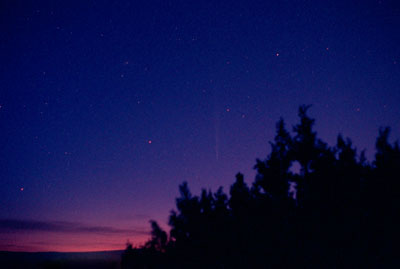Running about 4th to 5th magnitude in very bright morning twilight, the new sun-grazing comet is a challenge to photograph being very low in the eastern sky before sunup. Here, I did the typical tripod shot, on Fuji 400 with a twist in processing. The short star trails from the 30 second exposure were minimized around the comets nucleus by first rotating the image so that the trailing on the comets nucleus was vertical in the image. Then the image was copied and pasted twice onto the main image. Then the two layers were combined with darken. By shifting one pixel at a time in opposite directions on the layers, the trailing on the comet head was reduced from a long blurring streak to a pinpoint nucleus. The image was then rotated back to the standard orientation you see here. Since stars form arcs of different a radius of curvature in wide angle images such as this, the best you can do here is to select one radius - the comets trail for reduction. Instrument: Pentax K1000 with 50mm f/2.8 Taukamar Platform: Tripod Film: Fuji 400 Exposure: 30s Filters: NONE Location: Payson, Arizona Elevation: 5150 ft. Sky: Seeing 8/10, Transparency 8/10 Outside Temperature: 0 C Processing: Photoshop, PW Pro.
|
||||
|
|
||||
|
FastCounter by bCentral |
